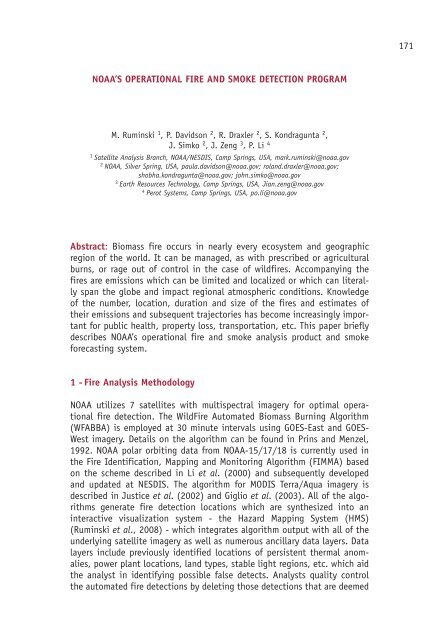7th Workshop on Forest Fire Management - EARSeL, European ...
7th Workshop on Forest Fire Management - EARSeL, European ...
7th Workshop on Forest Fire Management - EARSeL, European ...
Create successful ePaper yourself
Turn your PDF publications into a flip-book with our unique Google optimized e-Paper software.
NOAA’S OPERATIONAL FIRE AND SMOKE DETECTION PROGRAM<br />
M. Ruminski 1 , P. Davids<strong>on</strong> 2 , R. Draxler 2 , S. K<strong>on</strong>dragunta 2 ,<br />
J. Simko 2 , J. Zeng 3 , P. Li 4<br />
1 Satellite Analysis Branch, NOAA/NESDIS, Camp Springs, USA, mark.ruminski@noaa.gov<br />
2 NOAA, Silver Spring, USA, paula.davids<strong>on</strong>@noaa.gov; roland.draxler@noaa.gov;<br />
shobha.k<strong>on</strong>dragunta@noaa.gov; john.simko@noaa.gov<br />
3 Earth Resources Technology, Camp Springs, USA, Jian.zeng@noaa.gov<br />
4 Perot Systems, Camp Springs, USA, po.li@noaa.gov<br />
Abstract: Biomass fire occurs in nearly every ecosystem and geographic<br />
regi<strong>on</strong> of the world. It can be managed, as with prescribed or agricultural<br />
burns, or rage out of c<strong>on</strong>trol in the case of wildfires. Accompanying the<br />
fires are emissi<strong>on</strong>s which can be limited and localized or which can literally<br />
span the globe and impact regi<strong>on</strong>al atmospheric c<strong>on</strong>diti<strong>on</strong>s. Knowledge<br />
of the number, locati<strong>on</strong>, durati<strong>on</strong> and size of the fires and estimates of<br />
their emissi<strong>on</strong>s and subsequent trajectories has become increasingly important<br />
for public health, property loss, transportati<strong>on</strong>, etc. This paper briefly<br />
describes NOAA’s operati<strong>on</strong>al fire and smoke analysis product and smoke<br />
forecasting system.<br />
1 - <strong>Fire</strong> Analysis Methodology<br />
NOAA utilizes 7 satellites with multispectral imagery for optimal operati<strong>on</strong>al<br />
fire detecti<strong>on</strong>. The Wild<strong>Fire</strong> Automated Biomass Burning Algorithm<br />
(WFABBA) is employed at 30 minute intervals using GOES-East and GOES-<br />
West imagery. Details <strong>on</strong> the algorithm can be found in Prins and Menzel,<br />
1992. NOAA polar orbiting data from NOAA-15/17/18 is currently used in<br />
the <strong>Fire</strong> Identificati<strong>on</strong>, Mapping and M<strong>on</strong>itoring Algorithm (FIMMA) based<br />
<strong>on</strong> the scheme described in Li et al. (2000) and subsequently developed<br />
and updated at NESDIS. The algorithm for MODIS Terra/Aqua imagery is<br />
described in Justice et al. (2002) and Giglio et al. (2003). All of the algorithms<br />
generate fire detecti<strong>on</strong> locati<strong>on</strong>s which are synthesized into an<br />
interactive visualizati<strong>on</strong> system - the Hazard Mapping System (HMS)<br />
(Ruminski et al., 2008) - which integrates algorithm output with all of the<br />
underlying satellite imagery as well as numerous ancillary data layers. Data<br />
layers include previously identified locati<strong>on</strong>s of persistent thermal anomalies,<br />
power plant locati<strong>on</strong>s, land types, stable light regi<strong>on</strong>s, etc. which aid<br />
the analyst in identifying possible false detects. Analysts quality c<strong>on</strong>trol<br />
the automated fire detecti<strong>on</strong>s by deleting those detecti<strong>on</strong>s that are deemed<br />
171
















